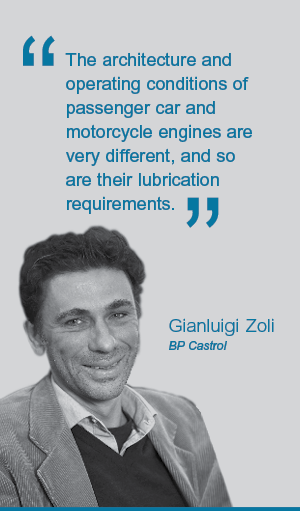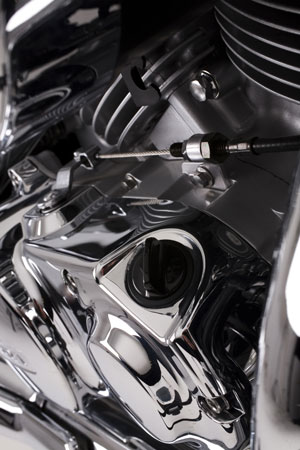Small Engines
Two-wheels rev up
08 July 2025
Please note this article was published in June 2014 and the facts and opinions expressed may no longer be valid.
05 June 2014
Diverging motorcycle market drives lubricant segmentation

Dr Gianluigi Zoli, Team Leader for Motorcycle Engine Oil Development, at BP Castrol talks to Insight about the changing global motorcycle market and explains why the use of dedicated motorcycle oils is becoming increasingly important.

The global motorcycle market is far from homogeneous, with significant differences between the mature markets of Europe and North America, and the emerging ones of Asia, Africa and Latin America. This divergence is very apparent in the sales figures for new bikes, which are rocketing in the growth economies, but are almost static in Europe and North America.
In Gianluigi Zoli’s view the market picture is unlikely to change in the near future. “In the next five years, demand for motorcycles is projected to grow in the key emerging markets. In contrast, the European and North American markets, which shrank as a result of the economic crisis (with Europe losing nearly 50% in five years), are unlikely to recover in the short term. This means OEMs who traditionally operated in these markets are now looking at the emerging markets as the only sustainable way to grow.”
Another example of the difference between these two markets can be seen in the types of machines users prefer. In the mature markets motorcycles are generally large, >500 cc, and are luxury items, used predominantly for leisure. Whereas in developing economies most of the two-wheeler market is made up of smaller motorcycles and scooters, which are relied upon as an everyday mode of transport – although with increasing affluence, this picture is starting to change.
“In developing countries, like India and Brazil, where bikes are used for commuting, typical engine capacities have been between 100 and 150 cc. However, as an effect of increasing wealth and changes in lifestyle, the use of motorcycles for leisure and sport is also becoming popular. This is particularly the case in India, where we can see this trend reflected in an increase in the number of bike models with sophisticated styling and larger engine sizes of up to 300 cc, that are being launched.”
Clearly the lubrication requirements of smaller motorcycles used for transportation differ from the needs of high performance large displacement motorcycles.

Lubricants must be able to protect the engine, clutchand gearbox of smaller motorcycles under extremetemperatures and loads
“Smaller air cooled motorcycle engines are amongst the toughest applications for lubricants,” explains Zoli. “They are used in some of the hottest and most chaotic cities in the world and are often overloaded to the extreme with people and goods. This means the lubricant must be able to protect the engine, clutch and gearbox under extreme temperatures and loads.”
The requirements of large displacement motorcycles, as you might expect, are very different. “These motorcycles are typically water cooled, and have a lower level of thermal stress than smaller bikes. However with engine speeds that can reach 16,000 rpm they are extremely sensitive in specific areas such as the conrod, bearings and gearbox. The wet clutch of a large bike is also subjected to extremely high loads, which means it requires well balanced friction in to order to operate smoothly.”
Not only do the leisure and utility motorcycles have very different requirements, but also the end users have different needs when it comes to lubricating their machines.
“There are significant differences depending upon region, and sometimes even country,” confirms Zoli. “In Europe, part or fully synthetic lubricants are predominant and oil changes happen on a yearly basis, which corresponds to a drain interval of between 4,000 and 10,000 kilometers – although this is highly dependent on user attitude. In North America motorcycle use tends to be seasonal and drain intervals are typically shorter than in Europe - often between 3,000 and 5,000 kilometers. And here mineral based lubricants still have the largest market share."
Zoli explains how the picture is very different in the developing economies. “In India, South East Asia, Africa and Latin America motorcycles are generally used all year round, and drain intervals can be as low as 1,000 kilometers in countries such as Vietnam and Thailand. Currently the lubricants used in many developing countries are mineral based SAE 20W-XX. However, the requirements of Japanese OEMs mean that high quality, fuel efficient oils, which are typically SAE 10W-30 or 40, are rapidly gaining a share of the market.”
In the coming years we can expect to see the market drivers of riding comfort, engine durability, emissions reduction and fuel economy impacting both engine design and lubricants. “Next generation lubricants need to be able to combine these very different features,” Zoli explains. “Friction balance and durability, with a particular focus on the dynamic part, are fundamental to maintaining smooth clutch operation and gear shifting, which enhances riding pleasure.”

Next generation lubricants must support fuel economyimprovement, emissions reduction, rider comfort andengine durability
Emissions legislation for motorcycles in the key markets is currently at Euro 3, with Europe now moving to Euro 4. “This means the current emissions control strategy with port fuel injection, lambda sensor and three way catalyst, will remain in place for at least the next five years. The reduction of emissions and fuel consumption is achieved by optimising friction, combustion efficiency and weight – with some of today’s 100 cc engines capable of travelling 80 kilometers on a litre of fuel."
This increased focus on emissions reduction and fuel consumption improvement means a shift towards lower viscosity oils is very likely. “Over the next few years, SAE 5W-30/40 fully synthetic lubricants will become more popular in mature markets and part synthetic SAE 10W-30/40 will become the mainstream grades in developing countries. This trend to lower viscosity means gearbox protection is becoming increasingly important, requiring improved wear and pitting control.”
The JASO universal motorcycle industry oil specification sets minimum limits for key lubricant parameters and aims to help consumers select appropriate motorcycle oils, and reduce field problems arising from the use of inappropriate oil. We asked Zoli if he believes the current specifications ensure adequate hardware protection.
“The JASO T903 standard is the only standard that addresses minimum performance requirements for motorcycle and scooter engine oils. The 2011 issue introduced a change in the friction classification criteria, with the objective of better reflecting the requirements of commercially available wet clutch materials.”
Future JASO specifications Infineum International Limited
Next JASO revision will still focus on friction classification with the introduction of the new standard wet clutch material and new reference oil used in the SAE#2 test, with the objective being to bring the specification as close as possible to actual hardware requirements. The next, big step forward for the JASO T903 standard would be the introduction of a mechanical rig test capable of discriminating oils in terms of wear and pitting protection. This would enable the removal of the current limit of 800 ppm phosphorus and enable the introduction of highly catalyst compatible formulation technology.
The market drivers of riding comfort, engine durability, emissions reduction and fuel economy are clearly impacting the design of motorcycle hardware. This means it is becoming even more important to use dedicated motorcycle oils rather than passenger car motor oils.
The architecture, operating conditions and lubrication requirements of car and motorcycle engines are very different. Infineum International Limited
The architecture and operating conditions of a car and a motorcycle engine are completely different and so are lubrication requirements. A modern car oil has a low friction coefficient which can cause issues in wet clutch, and its detergent and dispersant system has not been optimized for the high operating temperatures typical of a motorcycle engine. Also its viscosity characteristics are tuned towards around different speed and load profiles. More and more, car and motorcycle engine oils are becoming different lubricant categories.
Oil marketers offering products specifically tailored to provide balanced protection to the engine, gears and clutch will be at a distinct advantage in the growing motorcycle lubricant market.
Sign up to receive monthly updates via email
